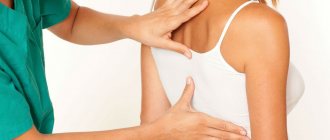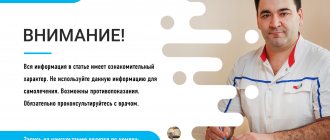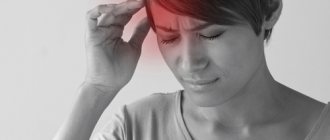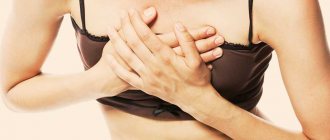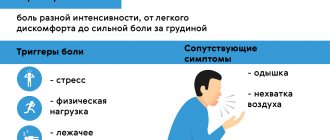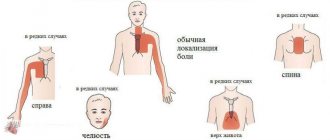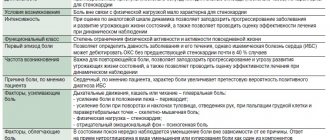General information
Cardialgia is a pain syndrome of cardiac origin. Pain is not always associated with organic pathology, i.e. caused by certain anatomical defects or heart defects .
There is a functional variant that is associated with disturbances in the functioning of the nervous system and the activity of the myocardial cardiac muscle. Cardialgia code according to ICD-10 is R07.2. The syndrome may vary in intensity, nature and be transient. Cardialgia can be provoked by a variety of factors. Cardiac syndrome is not a separate pathology, unlike other disorders of the nervous or cardiovascular system, and is only a primary diagnosis. Although this condition is not dangerous, this does not mean that it can be ignored. Pathology requires a thorough examination and a final diagnosis.
general information
The autonomic nervous system (ANS) is responsible for the unconscious regulation of the body. The movement of blood through the vessels, the digestion of food, the secretion of saliva - all these and many other processes occur automatically. The ANS itself is divided into two sections: sympathetic and parasympathetic. They are responsible for opposite processes and are in constant balance. Disturbances in this balance cause unpleasant symptoms, which form the clinical picture of NCD.
Adolescents and young women are more susceptible to the disease.
Pathogenesis
Pain syndrome occurs as a result of irritation of receptors that are located in the myocardium, pericardial sac or endocardium. Without special diagnostics and examination, it is impossible to identify which particular tissue area is involved. The localization of pain is not obvious; irradiation and return to the arm, neck, shoulder blade, and abdomen are possible. Pain syndrome is formed as a result of exposure to a negative factor.
These may be inflammatory processes in rheumatism , myocarditis , or an autoimmune process. Spasm of the coronary arteries in response to stressful situations is also possible. The intensity of the pain syndrome is not always an indicator of the severity of the patient's condition. Short-term lumbago is not typical for pathology of the cardiovascular system and is most often neurological in nature.
Prevention
Prevention of NCD is important not only for healthy people who are at risk, but also for those who are already closely confronted with this pathology. Changing your lifestyle, adjusting your diet and physical activity help strengthen the body and significantly reduce the risk of unpleasant symptoms. Doctors recommend adhering to the following rules:
- eliminate overtime, ensure daily proper rest;
- create the most peaceful atmosphere at home and at work;
- go to bed on time (duration of sleep at night is 8 hours or more);
- do not ignore walks in the fresh air;
- choose a suitable sport that will allow you to practice for your pleasure (swimming, walking, cycling, yoga, Pilates, etc.);
- adjust nutrition: the daily diet must meet the standards for caloric content, the ratio of dietary fat, the content of vitamins and microelements;
- minimize the consumption of food stimulants: tea, coffee, fatty foods, smoked foods, alcoholic drinks;
- drink at least 2 liters of clean water daily (other drinks do not count).
Compliance with these rules is useful for the prevention of not only neurocirculatory dystonia, but also many other diseases. The body always responds gratefully to care for it and begins to cope much better with inevitable stress and physical activity.
Classification
Non-coronary heart pain is divided into 2 forms depending on the pathogenesis. Both types occur without functional disturbances in the myocardium.
Psychogenic form
If, after a complete examination of the patient, no changes in the structure of the heart were detected, then they speak of functional cardialgia , in the formation of which the psychogenic factor plays a major role. Most often, this form of cardialgia is observed in young people with vegetative-vascular dystonia.
Provoking factors:
- violation of sleep, work and rest patterns;
- irrational, unbalanced diet;
- long-term stress and depression ;
- excessive physical activity.
The psychogenic type affects mainly young girls with a neurotic character.
Vertebrogenic form
Vertebrogenic cardialgia is observed in diseases of the upper spine. Pain can radiate to the heart area when the nerve roots of the cervical spine are pinched.
Often the vertebrogenic form develops against the background of osteochondrosis with a sedentary lifestyle. The position of the intervertebral discs changes, nerve endings are pinched and blood circulation is disrupted. The pain intensifies when raising the arms, turning the head and changing body position.
A similar clinical picture is observed with cervicobrachial syndrome , which is characterized by damage to the nerve endings of the brachial plexus and cervical spine. The pathology is typical for older people. In addition to the pain syndrome, numbness of the left arm and swelling are also noted.
Cardialgia can also be caused by Falconer-Weddell syndrome - this is a costoclavicular pathology, which is expressed in a narrowing of the space between the first rib and the collarbone. The neurovascular bundle in the left arm is compressed, which provokes pain in the left half of the chest.
Vegetative crisis
A vegetative crisis is a sudden failure in the functioning of the ANS. As a rule, it occurs in young patients. Depending on the symptoms, there are three types of crises:
- sympathoadrenal (panic attack): develops due to the release of stress hormones into the blood, as a result of which the patient’s blood pressure and pulse sharply increase, severe chills, anxiety, fear of death appear;
- vagoinsular: the opposite type of crisis, manifested by a drop in pressure and pulse, sweating and weakness; often accompanied by diarrhea;
- mixed: combines characteristics of both types.
Causes
Cardiac syndrome develops not only due to heart disease, but also for other reasons not related to the functioning of the cardiovascular system. Chest pain can be caused by pathological changes in the internal organs, spine, and respiratory system.
Related to the heart
Severe pain syndrome may be associated with the following heart diseases:
- Angina pectoris . The disease is associated with a violation of the supply of oxygen and nutrients to the myocardium.
- Myocarditis is an inflammatory process in the heart muscle.
- Myocardial infarction . Progressive ischemia provokes necrosis of the heart muscle.
- Cardiomyopathy is an increase in the size of the heart cavities and a decrease in its pumping function.
- Heart valve defects.
- Pericarditis.
- Hypertrophy of the right or left ventricle.
Other factors
Cardiac syndrome can be caused not only by heart disease. In this case, the pain radiates from another source and imitates cardialgia. Pathologies that provoke extracardiac cardialgia:
- Diseases of the musculoskeletal system: scoliosis , osteochondrosis , Falconer-Weddell syndrome , intervertebral hernia .
- Nervous system disorders ( heart neurosis , manifested by a complex of disorders).
- Dysfunctional disorders in the digestive tract: diaphragmatic hernia , ulcerative lesions of the intestines and stomach, esophagitis .
- Disturbances in the functioning of the endocrine system.
- Diseases of the respiratory system: pneumonia , bronchitis , pulmonary hypertension , pleurisy .
Pain syndrome can be caused by traumatic injury to the spine, pulmonary system, or abdomen.
Women during menopause, as well as during pregnancy, may experience chest pain of an idiopathic nature. In children and adolescents, pain may be associated with hormonal changes and a period of active growth. Such conditions do not require specific treatment and go away on their own.
Complications
NCD is not an independent disease, but it can cause the development of dangerous conditions. In severe dystonia and lack of adequate therapy, it can cause:
- myocardial infarction;
- ischemic or hemorrhagic stroke;
- cholelithiasis and urolithiasis;
- diabetes mellitus;
- arterial hypertension that does not respond to classical treatment regimens.
Malfunctions of the ANS also affect the immune system. Resistance to infections with this pathology is significantly reduced.
Symptoms of cardialgia
Description of the symptoms of the disease:
- Character . It can be very diverse, but more often it is: piercing; aching; burning; pressing; pulsating; squeezing pains. Some patients describe their sensations as discomfort in the chest, an unpleasant “feeling of the heart.” The range of pain sensations can be quite wide, but in most cases the pain is stereotypical.
- Localization . Most often, the pain syndrome is localized in the apex of the heart, in the precordial region and in the area of the left nipple. Some patients clearly point with their finger where it hurts. Migration of pain may be observed, and the syndrome may also have a stable localization. Cardialgia can be observed in the middle of the chest, behind the sternum.
- Current . The pain is wave-like and does not respond to Nitroglycerin . Pain syndrome is not associated with physical activity. Discomfort behind the sternum can be fleeting, long-lasting, short-term, frequent.
- Irradiation . The pain can radiate to the left hypochondrium, arm, under the shoulder blade. With psychogenic cardialgia, the pain syndrome radiates to the axillary region. Irration is often observed in the right half of the chest, in the lumbar region. Irradiation to the lower jaw and teeth is uncharacteristic (angina pectoris should be suspected).
Treatment at the Energy of Health clinic
Doctors at the Energy of Health clinic do not downplay the significance of the symptoms of NCD. We guarantee each patient a thorough examination, including all the necessary samples and tests, as well as selection of the most gentle, but at the same time effective treatment. At your service:
- drawing up a medication correction regimen in accordance with the characteristics of the course of the disease (not only the complex of symptoms, form and stage of the disease are taken into account, but also the emotional background, chronic diseases, hormonal status, characteristics of the patient’s work, etc.);
- restorative procedures: physiotherapy, massage;
- selection of physical exercises to perform in the gym with an instructor and at home;
- acupuncture;
- help from a psychotherapist and psychiatrist;
- selection of a resort for treatment in a sanatorium, collection of necessary documents;
- detailed recommendations for correcting lifestyle, nutrition, and physical activity.
We will help keep the disease under control and will always come to the rescue in case of exacerbation.
Tests and diagnostics
Working with patients who complain of chest pain begins with excluding life-threatening and acute diseases:
- acute coronary syndrome;
- microvascular angina;
- vascular spasm;
- aortic dissection or coronary artery disease;
- microvascular disease;
- pericarditis;
- drug-induced diseases;
- autoimmune pathology;
- cardiac tamponade;
- acute heart failure ;
- pulmonary embolism;
- pneumothorax;
- pneumonia;
- esophageal rupture, etc.
When assessing the condition of a patient with cardialgia in the emergency department, they are initially guided by the stability of hemodynamic parameters. A clinical examination and history taking allows us to determine the presence of edema, the location of pain, and its nature. When assessing hemodynamic stability, it is necessary to confirm or exclude life-threatening conditions. In any patient, respiratory and circulatory function is assessed, an ECG, biochemical blood test, chest x-ray and echocardiography are performed as necessary.
In an outpatient setting, a detailed history and physical examination data are important, which help determine the further diagnostic search. If a cardiogenic pain syndrome is detected, the patient is subject to a thorough examination by a cardiologist in an outpatient or hospital setting, depending on the prognosis of the disease and the severity of the condition. If the pain syndrome is associated with damage to the digestive tract, mental disorders, or damage to the musculoskeletal and respiratory systems, then the patient is referred according to the profile to the appropriate specialist for selection of therapy and further observation.
It is quite difficult to recognize and differentiate non-cardiac chest pain, and if the diagnostic search is stopped prematurely, especially in people with mental disorders, the risk of developing serious pathology, including diseases of the cardiovascular system, increases significantly. For timely diagnosis of psychogenic cardialgia, it is important to remember the peculiarities of its clinical course and adequately assess the patient’s psychovegetative background.
Treatment of neurocirculatory dystonia
Treatment of NCD has several goals:
- reduction in the strength and frequency of attacks;
- eliminating specific symptoms that cause discomfort in the patient;
- stabilization of the nervous system, in general.
The doctor’s task is to correctly select not only medications from various groups, but also non-drug treatment methods: physiotherapy, exercise therapy, massage, psychotherapy, etc.
The choice of specific medications depends on the form and severity of the disease. The patient may be prescribed:
- sedatives to eliminate excessive anxiety (Persen, valerian-based drugs, etc.);
- sleeping pills for poor sleep quality (donormil, zolpidem);
- tranquilizers in the presence of severe crises that occur like a panic attack, as well as in the ineffectiveness of softer drugs (afobazole, phenibut, atarax, etc.);
- antidepressants for excessive apatite, lethargy, depression; improve heart function, reduce pain (paroxetine, sertraline);
- nootropic drugs to improve memory, concentration and general stimulation of the body (glycine, piracetam, pantogam);
- drugs to improve metabolism in the brain (Actovegin, Cerebrolysin);
- angioprotectors to restore full blood supply to the central nervous system (Cavinton, pentoxifylline);
- antihypertensive drugs from the group of adrenergic blockers for increased pulse and blood pressure (anaprilin, bisoprolol);
- hypertensive drugs for low blood pressure (caffeine, mezaton, preparations based on ginseng and lemongrass);
- antioxidants that help strengthen the body in general (succinic acid, mexidol);
- multivitamins, as well as preparations with a high content of B vitamins to improve nerve conduction (milgamma, neuromultivit).
The selection of a specific combination of drugs, their dosage and regimen of administration is carried out only by a doctor, depending on the clinical situation and the individual characteristics of the patient’s body.
Non-drug treatments for NCD are used as an adjunct to medications. Their task is to strengthen the body and increase its resistance. The most popular are:
- physiotherapy: laser treatment, magnetic therapy, electro- or phonophoresis, electrosleep;
- massage of the cervical-collar area and general;
- physiotherapy;
- acupuncture;
- a variety of relaxing procedures: wraps, floating, applications, etc.;
- psychotherapy;
- Spa treatment.
It is important to remember that most of these techniques can only be used outside of an exacerbation.
Make an appointment
Treatment of cardialgia with folk remedies
Traditional medicine can help alleviate conditions and reduce the severity of pain, but the use of herbal remedies does not exclude a full examination and identification of the true cause of pain.
- Add figs, lemon, walnuts and honey to 50 ml of vodka. Infuse the mixture for 4 days. You need to take the tincture twice a day, 1 teaspoon.
- Boil hawthorn fruits in water. The resulting infusion should be taken three times a day, 30 drops.
- Add lemon peel, figs, honey and persimmon to vodka. Leave the mixture in a cool, dark place for a week. You need to take the solution three times a day, 1 tablespoon.
- Add dried rosemary to vodka. The resulting mixture should be taken 30 minutes before meals three times a day, 35 drops.
- Mix hawthorn fruits, marsh cudweed, motherwort, sage and oregano. The herbal mixture should be infused in a water bath for 10 minutes. Take the resulting infusion once a day, half a glass. The duration of treatment is 21 days.
